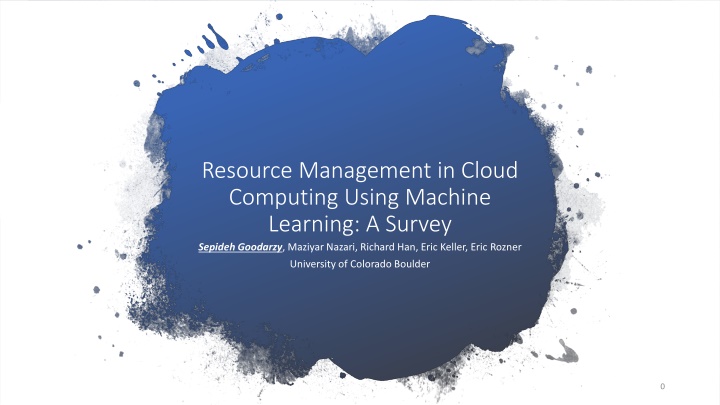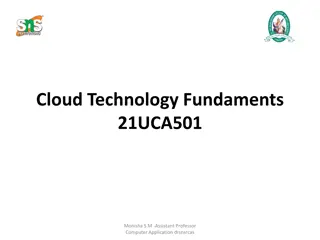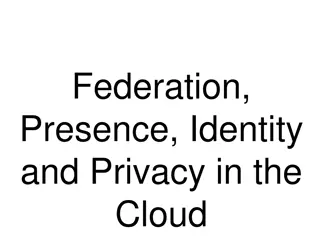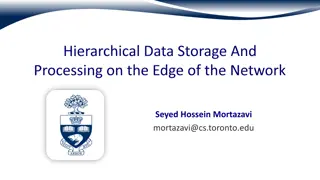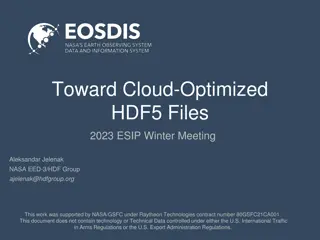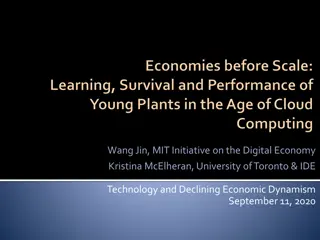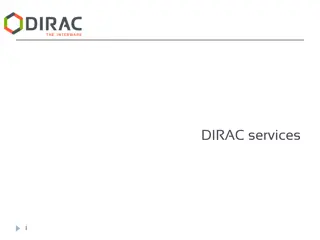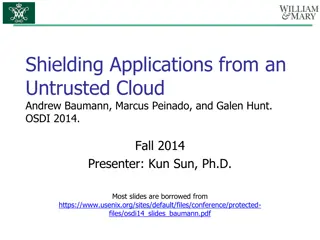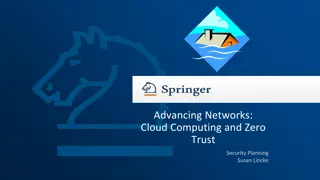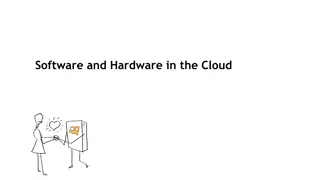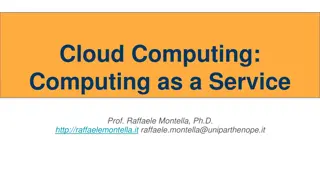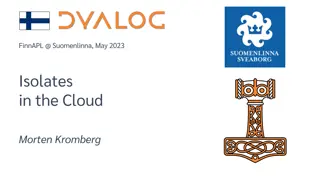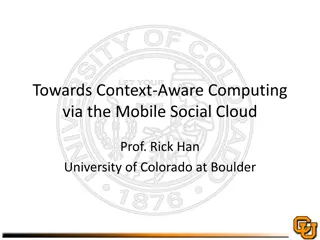Resource Management in Cloud Computing Using Machine Learning
This survey explores resource management in cloud computing through machine learning techniques. It covers objectives, priorities, resource utilization, algorithms, research works, and training methods in the context of cloud providers. Various machine learning approaches such as supervised, unsupervised, and reinforcement learning are discussed in the optimization of energy consumption and maximizing service level agreements in data centers.
Uploaded on Mar 11, 2025 | 1 Views
Download Presentation

Please find below an Image/Link to download the presentation.
The content on the website is provided AS IS for your information and personal use only. It may not be sold, licensed, or shared on other websites without obtaining consent from the author.If you encounter any issues during the download, it is possible that the publisher has removed the file from their server.
You are allowed to download the files provided on this website for personal or commercial use, subject to the condition that they are used lawfully. All files are the property of their respective owners.
The content on the website is provided AS IS for your information and personal use only. It may not be sold, licensed, or shared on other websites without obtaining consent from the author.
E N D
Presentation Transcript
Resource Management in Cloud Computing Using Machine Learning: A Survey Sepideh Goodarzy, Maziyar Nazari, Richard Han, Eric Keller, Eric Rozner University of Colorado Boulder 0
Cloud Providers Objective and Priorities Maximizing Resource Efficiency Minimizing Job Completion time Minimizing Delay Maximizing SLAs Minimizing User s Cost Saving Energy Resource Management 2
Resource Utilization Less resource slack, more resource efficiency CPU Limit More computing power, less delay, more SLA 3
Heuristics Knowledge Beforehand Algorithms How Have Researchers Targeted This Problem? Too General Machine Learning Dynamic, Workload-Specific, Does not Need Knowledge Beforehand 4
Research Works Targeting Resource Management SUPERVISED LEARNING UNSUPERVISED LEARNING REINFORCEMENT LEARNING 5
Supervised Training Data = Feature Values + Known Label Machine Learning Models Unsupervised No Label in Training Data Reinforcement Learning Agents Finds the best sequence of actions in an environment to to maximize the notion of cumulative reward 6
Reinforcement Learning Reward and Next State 3 1 State Instant gain is not important! Good For Decision Making! Agent Environment Action 2 7
Supervised Learning Towards energy-aware scheduling in data centers using machine learning Performance evaluation of a green scheduling algorithm for energy savings in cloud computing 8
Maximize SLA while optimizing energy consumption Turn off idle Machines Two main Techniques: Consolidate tasks J. L. Berral, I. Goiri, R. Nou, F. Julia`, J. Guitart, R. Gavalda`, and J. Torres, Towards energy-aware scheduling in data centers using machine learning, in Proceedings of the 1st International Conference on energy-Efficient Computing and Networking, 2010 9
LR M5P Predicted Current CPU% Usage Predicted Power consumption Recent CPU% Usage Dynamic Backfilling Predicted SLA 10
What happens if the load increases? 60 seconds booting time is not efficient! 11
Consider Different On/Off States Feedforward NN Recent Workload Turn on/off VM Current Workload T. V. T. Duy, Y. Sato, and Y. Inoguchi, Performance evaluation of a green scheduling algorithm for energy savings in cloud computing, in 2010 IEEE international symposium on parallel & distributed processing, workshops and Phd forum (IPDPSW). 12
Still solving single dimension bin packing problem with not optimum algorithms! 13
Unsupervised Learning Dejavu: accelerating resource allocation in virtualized environments 14
Deja Vu Deja Vu 1. Cluster workload based on their signatures (simple k-means) 2. Compute the required resource for each cluster with linear search 3. map workloads to available resources N. Vasic , D. Novakovic , S. Miuc in, D. Kostic , and R. Bianchini, Dejavu: accelerating resource allocation in virtualized environments, in Proceedings of the seventeenth international conference on Architectural Support for Programming Languages and Operating Systems, 2012 15
Same config for all the workloads in the same cluster even though they have different feature! 16
Reinforcement Learning Resource management with deep reinforcement learning Multi-objective workflow scheduling with deep-q-network-based multi-agent reinforcement learning 17
what about considering multiple resources (CPU, Memory, Network, etc) in problem space? 18
d resource type in the problem space (memory, cpu, etc) State space: The current re-source allocation, the resource profiles of the first M jobs waiting to be scheduled, #jobs stored in the backlog Action space: scheduling jobs A single Dynamic objective! Jobs can t be preempted! H. Mao, M. Alizadeh, I. Menache, and S. Kandula, Resource management with deep reinforcement learning, in Proceedings of the 15th ACM Workshop on Hot Topics in Networks, 2016 19
How about multiple dynamic conflicting objectives ? 20
Multi-objective Workflow Scheduling with Deep-Q- network-based Multi-agent Reinforcement Learning Decentralized deep-Q-network in Multi-agent RL setting Minimizing make-span time and user s cost optimization Considered Job Dependency DAGs! Y. Wang, H. Liu, W. Zheng, Y. Xia, Y. Li, P. Chen, K. Guo, and H. Xie, Multi-objective workflow scheduling with deep-q-network-based multi-agent reinforcement learning, IEEE Access, vol. 7, 2019. 21
Future Work Supervised Unsupervised RL Can be used hybrid with RL to estimate the resource usage profile of jobs Can be used hybrid with RL for handling adversarial changes Online RL (Meta learning) Unknown resource usage profile before hand (POMDP) Preemptable Jobs ( Multi agent) More than two objectives Drastic changes (Adversarial RL) 22
Thank you Email: Sepideh.Goodarzy@Colorado.edu 23
Questions? 24
